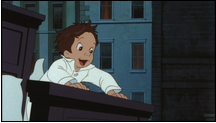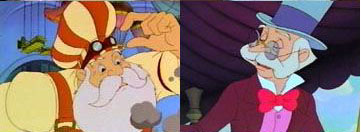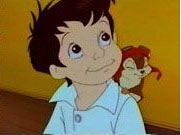Blog Post #3: Little Nemo: Adventures In Slumberland
Posted on: February 8, 2010
From around 1905 until around 1914, Winsor McCay’s comic strip Little Nemo in Slumberland ran weekly in both the New York Herald and New York American newspapers. The underlying story was about a young boy named Nemo who would weekly venture through a dream, only at the last panel to wake up in or near his bed, and usually be comforted or scolded by one of his parents. The dreams weren’t always child-like fantasy though, since Little Nemo was written mainly for adults as well as children; some of the dreams Nemo experience involved places that were, according to Wikipedia, “dark, surreal, threatening, and even violent” especially in earlier strips, which mostly focused on Nemo waking up before “some mishap or disaster that seemed about to lead to serious injury or death, such as being crushed by giant mushrooms, being turned into a monkey, falling from a bridge, or gaining 90 years in age.” However surreal it was though, Little Nemo definitely appealed to an audience, but nowadays it’s mostly forgotten by the general audience.
However, in 1989, Tokyo Movie Shinsha released an animated movie based on the strips entitled Little Nemo in theaters. 3 years later, it was given an English dub and released in theaters as Little Nemo: Adventures in Slumberland. During the production on the movie, animators such as Isao Takahata and Hayao Miyzaki were involved on the project, but both left due to differing views on how the film should’ve been, and were succeeded by Andy Gaskill and Yoshifumi Kondo. Even many animators from the Disney Studio including Ken Anderson and Leo Salkin worked on sequences, while Frank Thomas, Ollie Johnston, and Paul Julian contributed to the production.
Reception-wise, while Little Nemo: Adventures in Slumberland received positive reviews from publications such as the Washington Post, Variety, the New York Times, and the Boston Globe, it made about $407,695 with a total US gross of $1,368,000, and was considered a box office flop. However, to this day, the movie remains a cult classic and sold over 2 million copies when it went to video. Nowadays, the DVD is distributed by Echo Bridge Home Entertainment as a budget title, and can be easily bought online for around $6.99.
On a more personal note, when going through my “watch every animated film in the Kids Section of Blockbuster”, I came across the movie a few times, but never really thought to pick it up. However, the notion that the movie existed slipped back into my mind when we were talking about how Little Nemo was used as one of the first stop-motion color animations during the Roaring 20’s, so I decided to check it out. As both a fan of Japanese animated movies (such as the ones made by Hayao Miyazaki and Satoshi Kon) and animation in general, Little Nemo: Adventures in Slumberland feels like a dream-like trip back to my childhood, with a very imaginative environment, a colorful cast of characters, and a simple but charming story.
The main plot of the film involves Nemo and his best friend, a flying squirrel named Icarus, being visited in the night-time by a very tall man named Professor Genius and a little girl clown named Bonbon. They present Nemo with a royal invitation from the ruler of Slumberland, King Morphius, to come to his kingdom and be the playmate of the King’s daughter, Princess Camille. As Nemo and the crew arrive in Slumberland, King Morphius becomes immediately fond of Nemo and entrusts him with the Golden Key, which can open any sort of door in Slumberland. However, the King gives Nemo specific orders not to open the door which has a symbol that looks just like the key’s handle: a sinister-looking dragon. Later on, as Nemo meets Princess Camille and ventures around Slumberland with her, he’s immediately hurried by the Professor to begin his surprise schooling in preparation for Nemo’s duties as the future Prince of Slumberland. When the teachers are finished with schooling Nemo in just about everything, Nemo becomes sidetracked by a trickster named Flip, who takes Nemo along with him to cause mischief throughout Slumberland. After some juvenile mischief-making, Flip and Nemo stumble across the ominous door that King Morphius warned about. Despite Nemo having second thoughts about the whole thing, Flip nonchalantly opens the door. However, it turns out that the door is actually a portal to Nightmareland, a sinister and evil place which is also the home of King Morphius’ enemy, the Nightmare King. During a celebration party, the Nightmare King attacks and captures the King, so now it’s up to Nemo to defeat the Nightmares, rescue the King, and correct his broken promise.
The plot is very simplistic, almost like a tale right out of a children’s book of fairy tales, as it has the mystical element of Nemo slipping into his dreams and waking up in his bed, and a transition from cheerful, lighthearted fun in the first half into a dark and somewhat even terrifying journey when Nemo and co. enter Nightmareland. While the climax might be a bit anticlimactic and the story very baseline and extremely easy to follow to a lot of older viewers, it nevertheless carries a sense of charm and dream-like whimsy.
Character-wise, they all carry a sense of adorable charm, and their personalities, while simple, are quite enjoyable to watch. Nemo especially, because he acts like a typical 8 year old kid. He has a bad habit of sneaking pies before bedtime; he’s reluctant to go to Slumberland at first but after eating cookies from the Princess, he quickly accepts; the whole Nightmare incident is caused by his curiosity and following Flip, whom he was warned about. Still, Nemo is only a very naive kid, and realizes the disaster he accidentally caused, and matures just a little in his quest to save the King and Slumberland.
For a movie that has been made in the late 80’s/ early 90’s, the animation is very beautiful and colorful. Every aspect of the environment is extremely creative, from the many dream-like and vibrantly colorful areas around Slumberland, to the creepy, twisted, and cave/ swamp-like areas of Nightmareland, the color and animation still looks fantastic, despite the fact that it’s around 20 years old or so.
I would greatly recommend Little Nemo: Adventures in Slumberland to anybody who didn’t see it, anyone who’s a fan of Japanese animation/ animation in general, or if you sort of remember watching it in the past, seeing it for nostalgia’s sake. It’s a very sweet, charming movie, and you won’t regret getting whisked away into its dream-like wonder.
Sources:







Leave a comment